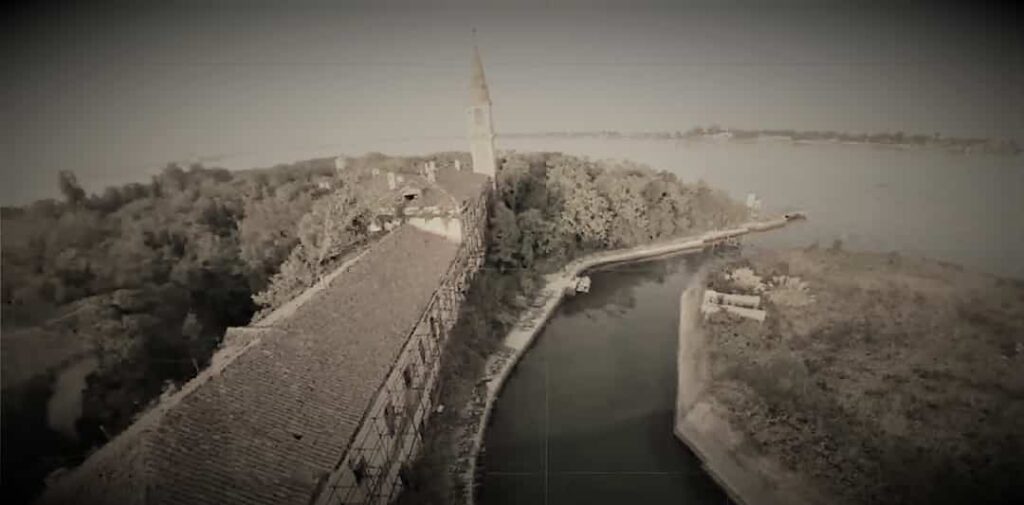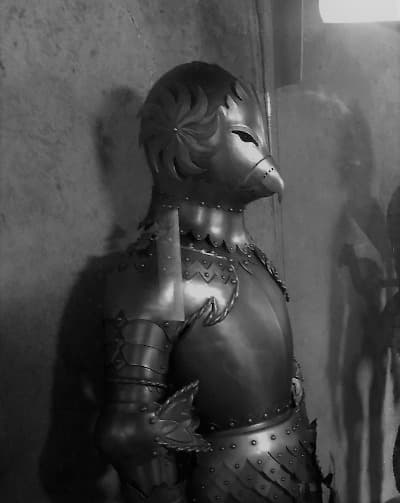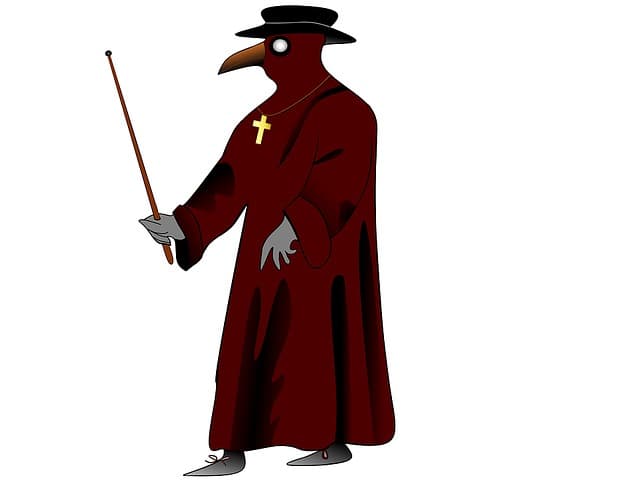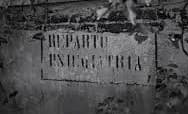Poveglia is an 18-acre triangle-shaped island in the Venetian lagoon 3 miles south of Venice. It was abandoned in the 14th century. It was then used as a military deposit, for docking, loading, and unloading ships, and later as a quarantine island. There are many legends about Poveglia Island and how it is supposedly being haunted. Some are true while others are not.

The small island of Poveglia is a truly scary piece of land. The wild-grown fruit trees and the crumbling buildings of red brick, covered with rampant ivy create an eerie feeling. It’s haunted. You enter the dark shadows under the old trees, some of which are long dead and now only point their naken branches towards the fading sunlight. Then, someone sighs right behind you, but nobody’s there when you turn around. And you suddenly regret that you ever decided to come here. Because this is a dangerous environment… And not only because the old structures are unsafe. In the obscurity of the black night, things lurk, that are much more hazardous than falling tiles and rotten floorboards.
Still, foreigners in search of a good story, journalists, and TV people frequently come to investigate. Many of them are just searching for an adventure, a good story, or some video footage to use on youtube. Others are researching the proposed paranormal activity on the island. But there are those who actually want to know the true story about the island. Poveglia, the plague island that some say is…
the most haunted place on earth.
Because there are two distinct ways to tell the story. One way is intriguing, thrilling, and full of surprises. The other way is soberer. Which one you prefer is up to you. But let’s start at the beginning because the beginning is the same for both stories.
Poveglia’s oldest documented history.

The oldest history of Venice is hidden in shadows and mist. But we know that before Venice became Venice, the lagoon was already inhabited. The muddy waters were home to fishermen, rangers, and other adventurers. There was the prosperous Salt production and there were Roman settlements like Torcello, the harbor of the very important Roman inland town Altino. The stronghold on the Lido island, Malamocco, was a well-defended Byzantine town, and there was Rialto. This latter was no more than a few cabins thrown out on the sand. But it would later become one of the most fascinating and powerful cities of all time.
If you look at Lido di Venezia and move your eyes to a spot in the middle, a little bit to the south. On the left side, inside the lagoon, you see a triangle-shaped island. That’s Poveglia, or Popilia as it was called in ancient times.
To go there, first, you have to be brave, very brave. And you probably would need to put up quite a lot of money too. Nobody in the Venice area would be desperate enough to do it for less than a fortune. The stories, telling about strange noises, movements in the shadows, flickering lights, and dark entities are as many as the people who are supposed to have died there.
But, a long time ago, Poveglia was a thriving community and for hundreds of years, there was nothing but happy people and good times there.
This is the story about Poveglia:
In 810 A.D. there was a war in the northeast of Italy. The Franks fought the Republic of Venice and they sieged Malamocco. After a fierce battle, Venice won, and Rialto, inside the lagoon, became the new capital. On that occasion, the Poveglian settlers proved themselves both great warriors and with strong loyalty to the republic. Therefore Venice granted them privileges. They were excluded from taxation and military service, and as a result, their already thriving colony flourished even more.

With the strong economy, more people came and Poveglia strengthened its influence on both the political and economic life of the marshland state.
But as always in happy stories, there would come a time of change. For hundreds of years, life on the island was nothing but good, until 1378 when the war with Chioggia escalated. Actually, it was the old conflict with Genoa that had burst into flames again, but the result was that Poveglia was evacuated. All of the inhabitants of the island were given refuge in Venice. There they lived on for centuries and they kept their local traditions intact, as well as their privileged relationship with the Doge.
The island was completely devastated though. The Chioggians destroyed it and with that, the prosperous time was at an end.
From the 14th century, Poveglia was a deserted island.
On many occasions, the Venetian Republic tried to restore some of Poveglia’s glorious past. They offered it to the Cistercian friars, they offered it to the Poveglian community in Venice. But the answer was always: No. As if they all knew something about, what was coming.
Because Venice, just like all other medieval cities, was struck by the worst and longest disease, mankind has known, The Black Plague. And it was hit many, many times. In fact, it was in Venice that the first-ever quarantine was invented. Quaranta is the Italian word for 40, and that’s how many days the newly arrived had to stay isolated before he was let into the city.
The Bubonic Plague and Poveglia’s role in fighting it.
The first case is said to have been in 1348, although some historians claim that the Plague was present already in the Roman era. Anyway, the wave that followed covered the city from one end to the other and killed half of its population. And this happened in more or less 6 months.
The second pandemic arrived in 1423. At this point, the Venetians instituted an official state-financed hospital, the first-ever in the world, on the island of Santa Maria di Nazareth later called Lazaretto.

From the 14th until the 18th century, Venice was inflicted by this terrible disease no less than 69 times. Some years the contagion was coped with by the authorities and resulted in just a few infected. Other times there were endless sufferings and uncountable losses. Those years, the bad years, normal life came to a complete standstill when even the most basic functions of society were halted because people kept dying.
The Venetian healthcare system.
In 1468 a new hospital was created, The New Lazaretto, Lazaretto Nuovo, was supposed to be the Quarantine, while the old Lazaretto should be the hospital that actually cured the ones already infected.
But think of it for a minute. Here we have a City with as many as 150.000 people, one of the few real metropolises of the Middle Ages, and in a very short time, maybe half of them die. The scenery must have been horrible. Men and women trying to survive in the midst of dead bodies and black rats carrying the disease from one person to the other… And the panic. This was the kind of panic that can drive people to do anything.
What follows here is the first version, one of the two ways that one could tell the story about Poveglia, the plague island.
Version 1 – Poveglia… The scapegoat
So the authorities had to come up with a way to liberate the city of the dead and the dying. And there was one island, that was out of the way, empty, and where nobody would claim the ownership… Poveglia Island.

The next two severe pestilences happened in 1575 and 1630. And now the republic was prepared. The two Hospitals, Lazaretto Nuovo and Vecchio, were functioning infallibly, but when that wasn’t enough, and very soon it wasn’t, the boats started turning away from the normal route and went south… To Poveglia. Here, there were no doctors or nurses and the patients were not supposed to be cured.
They were supposed to die.
One can only imagine the scenes that must have been burnt on the retinas of the poor dying citizens. The dead and the still living in a futile struggle for a last breath of life in a nightmare without salvation.
Surveys have concluded that there are areas on the island where the soil, the very ground, is made of up to 50% human organic remains. It’s as if the island itself was part of the torment. Some 30 meters north of the bell tower, there is a stone with an engraving.
ne fodias vita functi contagio requescunt MDCCXCIII.
Do not dig (disturb) the dead for contagion in life resting 1793

The last ship docked at Poveglia in 1799.
The purpose of the island as a last resort for the dying was unaltered for the two centuries to come. Hundreds of thousands of men, women, and children died there until 1799, when the last infected ship, a Spanish brig, was forced to moor here when the disease had been asserted on board. After the established time, eight of the crew had died from the disease, but almost all the others were in a state of shock. None of the Venetian officials were able to communicate with them. Only one sailor, a ship’s boy was sane.
He had been instructed to take shelter on the ship as a guard, while the others took refuge inside the main building on the island. The boy met with them every day until one night he heard strange and frightening noises from the woods behind the building. Shortly after he heard screams from his fellow marines, but being too scared, he didn’t have the courage to leave the ship. The morning after he found them all in one small room. All 23 of them, all close together, mumbling incomprehensive phrases, often in a language that was not Spanish nor any Italian dialect.
But it doesn’t end here…
The island remained uninhabited and deserted until the beginning of the 20th century. Though it formally continued being a structure for public health.
The Poveglia madhouse

In 1922 a new beginning was at hand for the grieving island. This time as an asylum. Mussolini had just come to power and the fascist ideology was fresh and strong. At first, the asylum probably functioned as such, but within a few years, the path went in another direction. The urge to protect the nation and protect the race brought a medical surgeon with a particular interest in racial biology to the hospital.
We don’t know his name, because all documentation from the hospital was lost after the war. We do know that he was an eager follower of the new disciplines, though, and soon he started doing experiments on the patients… Lobotomy. People say they could hear the men and women scream all the way to Lido on silent summer nights. In those days there were no anesthetics and since the patients were all mad, no particular precautions were called upon. And lobotomy includes drilling and sawing.

The story of the doctor ended in 1942. During all the years from 1922 and onward, the patients, as well as the nurses and other doctors, had complained about strange movements, lights, and voices. But as the patients were mentally ill, nobody cared what they said, and as the staff didn’t want to be associated with the dubious activity on the island, they probably didn’t insist.
It all ended in 1942 when the head surgeon completely lost his mind. Screaming as if assaulted by someone or something, he rushed to the old bell tower. There he ran up the old and disintegrating staircase all the way to the top and threw himself out of a broken window. It’s said that he didn’t die immediately, but a fog rose from the trees behind the building, closed in to cover his body, and choked him to death.
Poveglia’s final years
The asylum closed in 1946 and since then Poveglia has been empty. Nobody goes there, the fishermen stay clear of the island, afraid of picking up human bones or other remains in their nets. And even more afraid of the noises and screams coming from the decaying buildings at night. It’s strictly forbidden for any curious tourist in search of a ghost story to go there. The risk is that he wouldn’t be able to tell anything at all. Like the Spanish sailors in 1799.
In the 80s an American businessman bought it. After 8 months with the Italian bureaucracy, he finally got all the permissions to start the construction works, and it progressed for three days. After that, all activity suddenly stopped and nothing more happened. A year after he had sold the property.
This is the story as you could have picked it up on an American TV channel or on a website about paranormal activity. Or on YouTube. There you can find numerous videos about all the terrible things that happened and still happen there. It’s a well-known story. At least among Americans, British, and anyone else understanding English.
Poveglia… The scary island in the Venetian lagoon. The most haunted place on earth.
And I could have stopped there. It’s a good story. And like many good stories, it’s based on true, historical facts. The Black Plague is all true. People died in numbers we luckily haven’t seen since. At least not in percentage of the population. And Venice suffered more than many other cities, being a lively trading community, and trading mostly with the eastern Mediterranean.
Poveglia was evacuated, devastated, and left deserted.

But the rest of the story, the true story, isn’t very scary. And it isn’t very old. The true story starts in 2001. This is the second version… What really happened on the most haunted island in the world.
In 2001, the Fox Family Channel created a series called The scariest places on earth, and for that, they needed destinations that could serve as a frame for content that was mostly, or in this case, totally invented. In episode 24, named Island of no return, the Poveglia Island is visited. The reporters, or the family, because they’re really ordinary people, run around in the darkness with the usual handheld camera. You hear them gasping and whispering under the Psyko-style scary music. And the story is told of the plague and of the mad doctor.
A few years after that, another TV show made an episode. This time it was Ghost Adventures on Travel Chanel and it was aired on Friday the 13th (!) of November 2009. Poveglia Island is the name of the episode, and just as in the case with Fox Family, we have to suffer three-quarters of an hour of gasping, panting, and anxiously calling from one room to another. All filmed with a hand-held camera in a semi-black and white, darkish color.
 Version 2 – The truth about Poveglia.
Version 2 – The truth about Poveglia.
And no, there are no hundreds of thousands of plague victims in the ground. The only plague ships put in quarantine on Poveglia were the two last ones in 1793 and 1798, possibly 1799. From 1782, Poveglia was a part of the sanitary structures of Venice. Lazzaretto Vecchio (the old…) and Lazzaretto Nuovo (the new…) were both old and insufficient and Poveglia was used as an extension of their activity. It became Lazzaretto Nouvissimo (the newest…). The two ships were quarantined there, and on the last ship, it’s true that 8 sailors died but together with the ship in 1793 that would sum up to around 20, not hundreds of thousands. And the rest of the crew lived on happily.
There is no record of any other deported, infected by, or deceased from the Bubonic Plague in any of the buildings on the island. It was used as quarantine during the 1800s though. Because the plague wasn’t the only infective disease threatening Venice. In 1835 Cholera broke out in Venice as it did in all the rest of Europe. But from cholera, there weren’t the same amount of deaths. It was less devastating than the Bubonic Plague if you can ever grade tragedies like these.

The mad doctor is most likely just a myth.
From 1922, there was a geriatric clinic though. As Venice was still crowded and to some extent unhealthy, it was a good idea to let the old patients come to an island with green areas, trees, and grass. Of cruel experiments, there are no records. Nor of any suicidal jump from the bell tower. The Madhouse story probably originates from a sign with Psychiatric Clinic present in one of the buildings.
We still don’t know how active this psychiatric ward was in those years. Psychiatry could be quite gruesome in the 20s and 30s, and surely many patients were treated roughly. Methods bordering torture were used on mentally ill patients, all over the world. But we have no documentation of any medical doctor distinguishing himself in any way. And there is absolutely nothing about suicides by jumping from Bell Towers.
Lobotomy became accepted as a treatment but not until the late 1930s. Sometimes the name Gottlieb Burckhardt is mentioned, but he died in 1907. There is no record of this mutilating technique ever being performed on Poveglia. It is easy to conclude that the whole story about the mad doctor was spawned from that, old signboard and that there is no truth in it whatsoever.
So what do the Venetians say?

When I talk about Poveglia with my friends and colleagues, they say: “Yeah… We used to go there when I was a kid. To play in the grass and have a barbecue. It was very nice. Peaceful… Full of rabbits.”
Some still go there, even though it’s prohibited. And even if it’s completely and utterly in disuse, and nature has more or less reclaimed all of it, it really is a nice place. Apart from the hazardous old buildings with cracked walls and roofs that are falling in. It’s also uninhabited so nobody bothers you if you want privacy, or even if you stay the night… Did I mention that it’s forbidden?
If you’d like to try your luck, you don’t really need any particular courage. You need money though, as you have to get a private boat to take you there. You could try asking a taxi, but it could prove difficult to convince anybody to take you. The reason for this is obviously that it is closed to the public. To go there legally you need special authorization from the City. And the reason it’s closed doesn’t have anything to do with ghosts or phantoms. It’s simply too hazardous due to a general lack of maintenance. The buildings are crumbling.
There are not many options remaining. One is to simply bribe somebody to drive you there anyway. And that could mean a considerably higher price tag. And remember to bring your own lunch. On Poveglia there is absolutely nothing more than old buildings falling apart, nature, and rabbits.
You could use one of the many boat-renting companies. Many of them have reasonably fast electric boats that could bring you there in a short time. Just remember that it’s forbidden to dock. It’s even forbidden to get close or to pass through any of the two canals on the island.

Initiatives to save Poveglia Island.
In 2013 the Italian government decided to start selling off some of the historical properties that until then had been on their table. The project, Valore Paese, opened for Poveglia, together with other sites, to be rented out for 99 years at a public auction. On the 13th of May 2014, the highest bidder was the present Venice’s Major Luigi Brugnaro with 530.000 euros. The acquisition was determined as being incongruous and the outcome was revoked.
Many citizens found it somewhat unethical for the Mayor of Venice to try and make a fortune by turning an important piece of Venetian history into yet another luxury hotel. So an association was founded: Poveglia per Tutti, Poveglia for everyone.
This Association pushes forward along two paths. One is building up funds by asking for donations, mostly among normal Venetians who don’t want to surrender Poveglia to the tourist sector. They have gathered almost half a million euros until 2021. The same money, Brugnaro used to win the auction in 2014.
Poveglia Island – The future.
The second path is to raise awareness about the obvious risks the island could face. In this context, they have been trying to establish a dialogue with the State Property Agency to no avail. For now, they just want to be allowed access to the island. The buildings are now in such bad shape that the risk of collapse is imminent. The vegetation is also so overgrown that any maintenance of anything at all on Poveglia is almost impossible. Poveglia per Tutti just wants to clean it up a bit, but until now, they haven’t been allowed to.
But in 2018 a sentence from the TAR, the Italian regional administrative court, determined that the State should at least talk to Poveglia per Tutti. Nothing more than that, really, but the sentence together with an increasing interest from the general public, and with that political weight, makes the future very uncertain. And coming from a planned multi-million dollar project aimed at rich tourists, an uncertain future is a huge leap in the right direction.